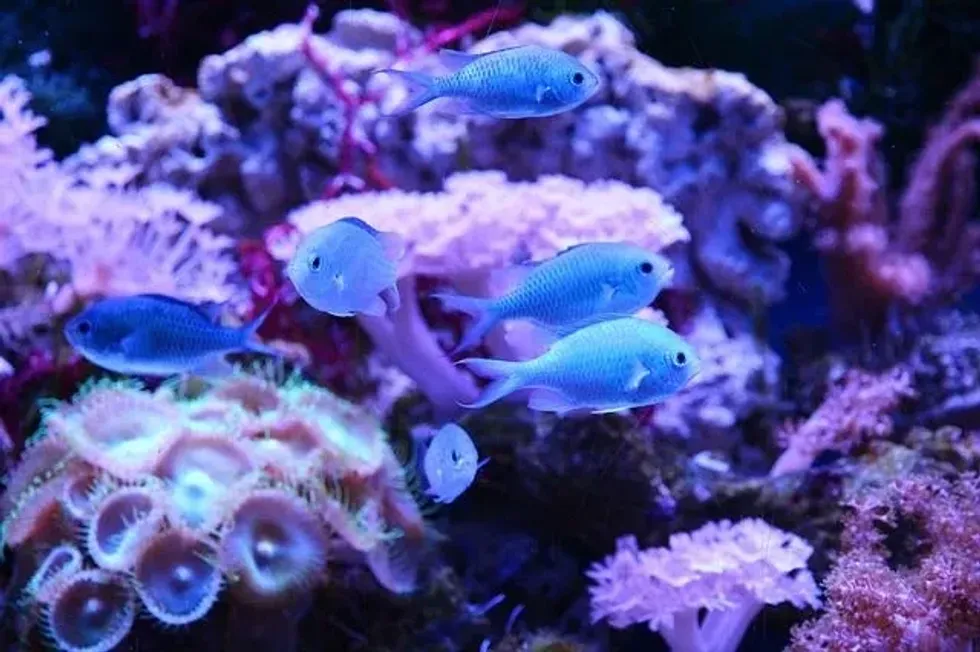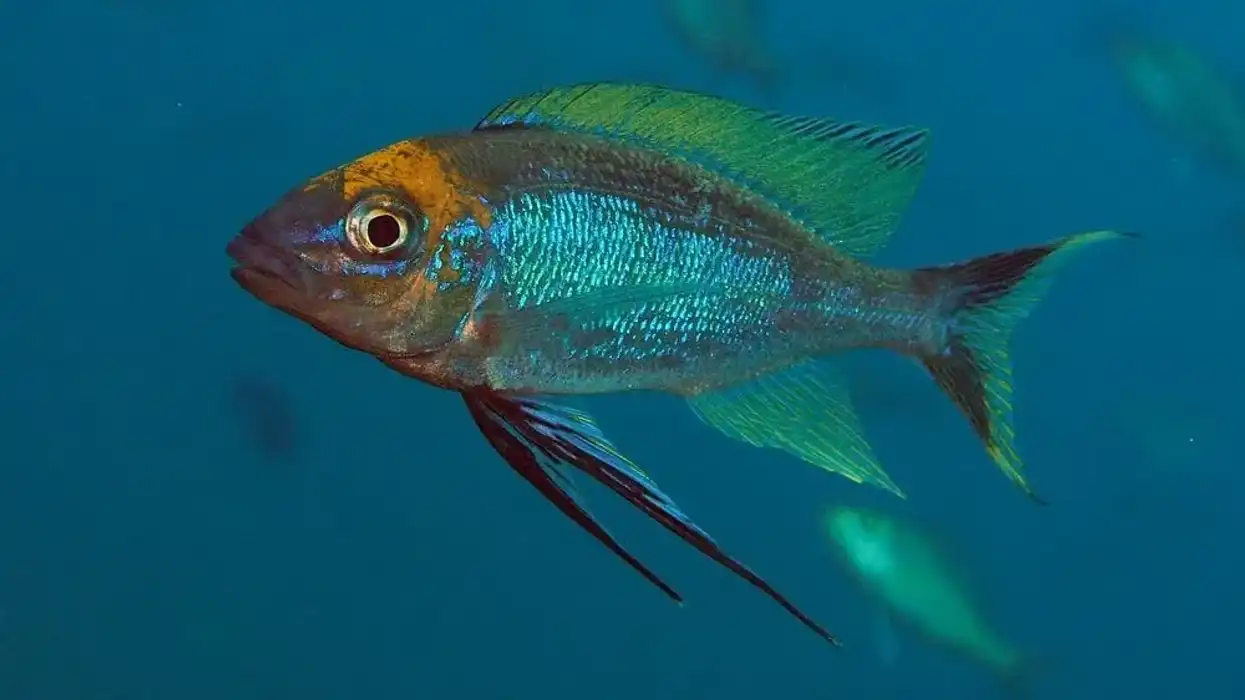The blue chromis, also known as blue damselfish, are shallow-water fish, commonly found at depths of 3-5 m, but can reach 25 m depth of below seawater. It is a genus of saltwater fish that belongs to the Pomacentridae family, and scientifically known as Chromis cyanea.
They are primarily found in the western Atlantic ocean, including the Caribbean sea and the Gulf of Mexico, extending to Bermuda and lesser Antilles. Their life begins as soft demersal and translucent eggs and they are still small in size as adults.
These fish are often known as tank fish since they are mostly kept as a pet in an aquarium. Chromis cyanea is a type of damselfish, and also known as blue-green chromis due to its mixture of blue and green bright color in its scales.
There are 100 different species of chromis fish and many of them are found commercially in the aquarium trade.
The adult chromis tend to swim in and out of the coral similar to Acropora as small schools above their natural habitat of large shallow reefs. However, the juvenile stays in the rockwork till they are big enough to join the adult school.
If you are amazed by the damselfish or blue chromis fish facts, then you may also want to check out neon tetra and electric eel facts too.
Blue Chromis Interesting Facts
What type of animal is a blue chromis?
These fish are a type of damselfish which are usually kept as aquarium fish.
What class of animal does a blue chromis belong to?
As a fish, it belongs to the Actinopterygii class of animals, also known as ray-finned fish.
How many blue chromis are there in the world?
The total number of blue chromis present in the world is uncertain since many are found in the ocean, while some are kept in the aquarium, and their population is increasing and stable.
Where does a blue chromis live?
The chromis fish species are generally found in the ocean, tropical, saltwater, or marine in between rock holes.
They usually reside in waters with a temperature of between 72-78 F. They can be found in different parts of the world where mostly in saltwater, and they are named according to the regions they belong to, including Atlantic blue chromis, Caribbean blue chromis, and are also found in the Indo-Pacific but not in a large number.
What is a blue chromis's habitat?
The Chromis cyanea are found in reef communities and lagoons between depths of 3-60 m. They are commonly found at 10-20 m depths where shelter and food are abundant for survival. These fish prefer water temperatures between 21-27°C, which is the same perimeter required for coral survival since healthy coral is of vital importance to the fish.
It provides them a location for their breeding, protection from predators, as well as for feeding.
The male fish maintains small territories with flat nesting areas or crevices with small openings mostly among staghorn coral, while the juveniles' habitat consists of a coral head, yellow finger coral, or smooth flower coral. They are mostly found in the Caribbean coral reefs.
Who do blue chromis live with?
These fish species generally live in a small school with their own species and feed together. Some of them have been seen to reside alone, especially adults, but during breeding or feeding, they usually appear in groups.
How long does a blue chromis live?
The lifespan of these fish can range between 8-15 years, while most of them generally live for 11 years. If they are lucky enough to survive from predators or have been raised in tanks, then they can live up to 15 years. But 15 years of lifespan is quite tough for those living in the wild.
How do they reproduce?
The damselfish or blue chromis cyanea are promiscuous and the males mate with multiple females. Their reproduction behavior process includes males performing something called a signal jump to solicit females, in which the males quickly propel themselves upward and then loop back to their starting position.
They also perform 'dipping' during which they swim in a zig-zag pattern above their territories. If the female does not interrupt the display, the male will lead her to his nest to breed.
Spawning occurs once a month, during the full moon, and lasts for three to seven days.
The females can lay up to 40,000 eggs scattered in the nests, while the male may begin to solicit other females to mate with. The eggs hatch within two to three days of spawning, as independent larvae and are cared for by the male chromis.
What is their conservation status?
This fish species is of Least Concern in its conservation status, since their population seems to be stable, and with many of them being raised in fish tanks or aquariums as pets, most of them are safe. However, those living in the ocean may be faced with many threats from predators, as well as climate degradation.
Blue Chromis Fun Facts
What do blue chromis look like?
As a member of the damselfish, the chromis cyanea have an average total body length of 3-5 in (7-13 cm) as it grows to adulthood. They have a compressed and oval-shaped body with iridescent blue, greenish shiny scales, with a black stripe on the dorsal, caudal, and anal fin.
They have dark eyes which makes it easy to distinguish this species among other similar ones.
These fish species have a small, terminal mouth, deeply forked tail, and continuous dorsal fin. The male and female chromis slightly differ in colors or patterns, where they may exhibit one of the five color morphs which include light blue shades and dark gray-blue, along with variations in dorsal stripe thickness.
How cute are they?
They are small and iridescent blue color fish, and their unrelaxed behavior is very cute to watch.
How do they communicate?
The means of communication between these fish are uncertain and hard to recognize.
How big is a blue chromis?
The blue chromis are usually the size of a clownfish, which is why they fit well in tanks or aquariums since they also have similarities in nature.
How fast can a blue chromis swim?
Blue reef chromis are small in size and do not have a good swimming speed as compared to other medium-sized fish. They can swim around their habitat in a small school or group but are rarely seen swimming to other regions or parts of the ocean. They are non-migratory fish species.
How much does a blue chromis weigh?
An adult blue reef chromis weight range is from a minimum of 200-300 g, which is as much the size of a clownfish.
What are their male and female names of the species?
The male and female damselfish blue chromis do not have separate names.
What would you call a baby blue chromis?
The baby damselfish are commonly known as larvae as soon as they hatch and later are known as chromis babies.
What do they eat?
The diet of these fish includes algae, seaweed, plant seeds, or small fish. They are omnivorous fish species.
Are they aggressive?
These fish do not possess aggressive nature of behavior and they are quite friendly if kept with other small fish species of their size.
Would they make a good pet?
A blue chromis pet is one that many wish to have in their fish tank. They are friendly, peaceful, and cute to watch with their glowing blue color. Often clownfish are made to live in the blue chromis tank too since they both really get along without having to worry about big predators.
Did you know...
The damselfish chromis are very hardy and are the most non-aggressive fish that are best suited for aquarium fish.
Blue chromis vs blue-green chromis
These fish are both similar in nature and have common colors of blue, but the blue-green chromis has a tint of a greenish look in its scales on its body.
Having your own blue chromis
You should keep at least five to seven of these fish in a tank since they stay in a group, and which will make them feel confident and stress-free in the tank.
It is important that you give the blue chromis care and timely feeding, along with the right water temperature, as similar to saltwater as possible, since they can easily die if the water temperature is not pleasant for them.
Ideally, they must be fed thrice a day and once if the tank is small.
Here at Kidadl, we have carefully created lots of interesting family-friendly animal facts for everyone to discover! Learn more about some other fishes including giant grouper or rainbow cichlid.
You can even occupy yourself at home by drawing one on our Blue Chromis coloring pages.









